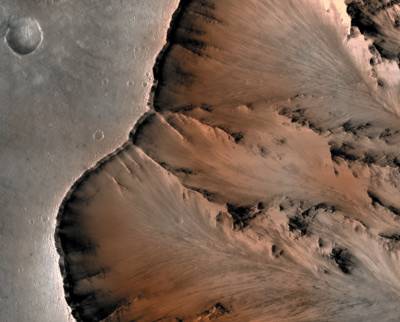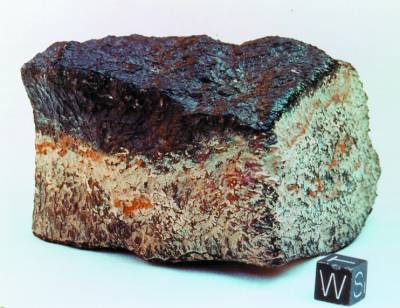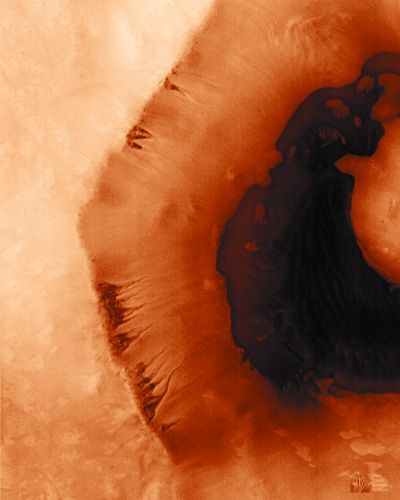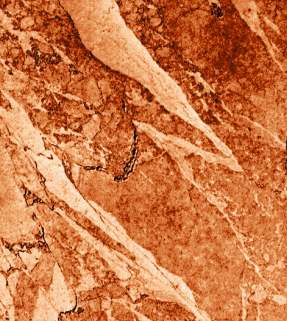That’s precisely what makes the latest findings about Mars so extraordinary. Just five years ago, astronomers viewed the Red Planet as an old, essentially dead world. Recent discoveries made by the Mars Global Surveyor spacecraft and gleaned from martian meteorites now suggest a world where active volcanoes and underground rivers of liquid water may exist today. In many ways, this emerging view bears a closer resemblance to the Mars envisioned 200 years ago than the one planetary scientists saw in the mid-1990s.
Our story begins around 1800, when William Herschel and other observers pointed large telescopes at Mars. They saw clouds, polar ice fields, and dark markings that could be construed as oceans, all giving the impression that Mars was much like Earth. These observations led to the hypothesis of the plurality of worlds — that other planets were Earthlike. Mars presumably had an active meteorological and geological environment, like our own.
By 1900, Percival Lowell correctly pointed out that a small planet like Mars would lose its internal heat and atmosphere faster than a large one like Earth, and he pictured Mars as a dying, drying planet. Perhaps it once had an earthlike environment, but it was running down. Oceans were soon ruled out, and the martian air was proved to be very thin. In 1965 humanity’s view of Mars reached its dismal nadir when the first successful Mars probe, Mariner 4, zipped past Mars and revealed no mountains, seas, lakes, canyons, or rivers, but rather impact craters like those on the moon. In an overreaction, scientists concluded that Mars was even more dead than had been thought — a moonlike world where only the occasional asteroid impact disturbed the planet’s endless sleep.
This gloomy picture began to change in the 1970s, when Mariner 9 and two Viking spacecraft arrived at Mars. They revealed dry riverbeds, volcanic mountains, and sparsely cratered plains with lava flows. Clearly the planet had not been dead or passive but had experienced volcanic eruptions and flowing water that carved river channels winding hundreds of miles across its surface. Nonetheless, scientists agreed that the eruptions and river flows must have been confined to a primordial active period, perhaps 4 billion years ago, when Mars still had a hot interior and thick atmosphere.
The questions to ponder were, when did this active period end? What were the most recent lava eruptions or flows of liquid water? A widely quoted paper of the 1970s, by the German-American team of Gerhard Neukum and Donald Wise, studied the age relationships and the accumulated number of asteroid impact craters and concluded that all volcanism had stopped by 2.5 billion years ago. This picture was what we might call the “Old Age Mars,” with all activity ending in the first half or third of martian history. (For comparison, on the active Earth, the Atlantic Ocean basin is only about 70 million years old, the Gulf of California only a few million years old, and the San Andreas fault still carries Los Angeles to the north and west.)
The view of martian history continued to evolve in the 1980s. Neukum, working with K. Hiller, published a new analysis that concluded most martian activity was still old but the tail end of volcanism extended into more recent times. Similarly, a NASA-sponsored study of basaltic volcanism in the solar system took a fresh look at martian crater accumulation and concluded that many lava plains were between 1 billion and 2 billion years old with the famous volcanic cones, such as Olympus Mons, as young as a few hundred million years.
Soon after, scientists recognized that a handful of meteorites on Earth had come from Mars. The first good dating of these rocks identified one group as lavas that solidified 1.3 billion years ago. The data seemed consistent, giving a picture that we might call the “Middle Age Mars.” In this view, most of the river channels formed early in Mars’s history but much of the active geology continued into the middle third of the planet’s life and the rare, last gasps of volcanic activity persisted into the last few hundred million years.
The Middle Age Mars endured into the 1990s and formed the basis for most of the planning that went into the current round of Mars missions. Yet this picture is now being overturned by recent developments. New dating of martian meteorites and results from the current Mars Global Surveyor mission portray a “Youthful Mars” &span; a planet with ongoing volcanic activity and flowing water.
The martian meteorites, now numbering just over a dozen, can be divided into several groups. One group crystallized 4.5 billion years ago as the planet was forming, was subjected to some sort of shock (probably from an impact) around 4 billion years ago, and then was blasted off Mars by an impact about 14 million years ago. A second group consists of basaltic lava that erupted and solidified 1.3 billion years ago and was blasted off Mars some 11 million years ago.
The third group plays a key part in the current revolution in martian thinking. These meteorites seem to have solidified only 100 million to 700 million years ago. Many researchers initially thought that these ages were too young to reflect geological activity on Mars and suggested instead that the ages might reflect when the rocks were shocked or melted by a major impact. However, modern research on the mineralogy of these rocks has convinced most scientists that they really did crystallize from molten material 100 million to 700 million years ago. The groupings of rock ages probably represent three or four different impact sites on Mars.
So the first revolutionary fact is that geologically young rocks apparently are not rare on Mars. After all, many of the martian meteorites formed from molten magmas only a few hundred million years ago, and two of the impact sites launched rocks no older than 1.3 billion years of age. This means rocks were forming not just in the first or second third of martian history, but within the last ten percent of the planet’s lifetime.
The second revolutionary fact is that liquid water apparently flowed on the surface of Mars and percolated into these rocks in the same general time span. For example, University of Arizona researcher Tim Swindle and his colleagues found that rustlike minerals caused by weathering formed inside cracks in one of the 1.3-billion-year-old basalts only about 650 million years ago, with an uncertainty of around 20 million years. This finding is independent of the other young ages.
Furthermore, many of the martian meteorites in the 100-million to 700-million-year group have rustlike minerals, carbonate deposits, or clay minerals inside them that formed by the action of liquid water. This proves that at least some locations on Mars have been exposed to liquid water, concentrated water vapor, or both within the last few hundred million years — an idea few planetary scientists would have accepted even five years ago.
A third revolutionary fact comes from the Mars Global Surveyor (MGS) mission. Some members of the MGS research teams like to joke that MGS is the Stealth Mission to Mars. The spacecraft arrived at Mars shortly after the famous Mars Pathfinder landing of July 4, 1997, and that dramatic mission, with its airbag touchdown and Sojourner rover, completely overshadowed the MGS orbiter in the media. Two years later, with MGS well into its mapping mission and turning out thousands of detailed images of the Red Planet, the failure of both Mars Climate Orbiter and Mars Polar Lander again deflected attention away from MGS’s new data.
Among the photos, MGS team members such as Alfred McEwen in Arizona and Mike Malin and Ken Edgett in California have recognized extremely fresh-looking lava flows in the Elysium Planitia region, with rugged lava textures barely modified by dust deposits or subsequent impact craters. My own work on the MGS team was to count the number of impact craters on these and other surfaces. To our surprise, we found that the youngest lava flows have less than one percent as many craters as the lunar lava plains where Apollo astronauts walked.
Through the combined work of researchers such as Boris Ivanov in Russia, Alessandro Morbidelli and Paolo Farinella in Italy, and Bill Bottke and Luke Dones in the United States, we now know that impact craters of the same size formed on Mars at roughly the same rate as on the moon. This means that the young flows on Mars can’t be more than about one percent of the age of the lunar lava plains, or perhaps 20 million to 60 million years. Some flows in the area may be even younger. We have also estimated ages of less than 100 million years on the youngest flows on Olympus Mons and ages around 200 million to 400 million years on broad lava plains of Tharsis and Amazonis Planitia.
This suggests that the youngest activity on Mars has extended to the last one percent of the planet’s history. If martian volcanoes have been active through 99 percent of martian history, there’s no reason to suppose that they all shut down just before we humans arrived. In other words, the new MGS data strongly argue that volcanism on Mars has continued into modern times and that the volcanoes will erupt again in the future. Whether this might be in the 21st century or a million years from now, we can’t say.
The fourth revolutionary fact also comes from MGS. The spacecraft found several examples showing that underground liquid water likewise exists in modern geologic time and perhaps could be found by astronauts. MGS researcher Michael Carr of the U.S. Geological Survey has pointed out that the headward or source-region ends of some martian river channels are fairly abrupt, without any smaller runoff channels to feed them. This suggests that the water supplying those channels did not come from the surface, as would be expected for runoff from rain or snow, but from underground.
More provocatively, Carr has found rows of collapsed pits extending beyond the source of the channel into the martian desert. In other words, the channel extends underground in the upstream direction, and the ground collapsed here and there into the underground feeder. This type of collapse into underground cavities, created as water dissolves or erodes underground rock, is common on Earth in so-called karst terrain, where limestone caverns are found.
The presence of possible springlike seeps in crater walls or cliffsides offers another line of evidence for underground water sources. Early in the MGS mission, imaging team leader Mike Malin released an image of a disturbance halfway down a crater wall. Below this is a narrow gully that runs down into the floor, where some dark deposits can be seen.
This implies that underground liquid water flowed out of the wall and then ran down, eroding a gully. French-American researcher Nathalie Cabrol has pointed to other examples and emphasizes that some craters may have contained ponds or lakes. All these features look surprisingly young, having few or no impact craters on them. Also, there is widespread evidence for downslope erosion and deposition of cliff face materials continuing to this day, so if these 100- to 200-foot-wide features were old, they would have been blanketed and hidden long ago.
Combining all this evidence — some martian meteorites were exposed to water within the last several hundred million years, the water flow most likely did not stop just before humans arrived, and we see places where water seems to be seeping out from underground in more recent geologic time — provides a compelling argument that, at least in a few regions, aquifers exist at a depth of perhaps a few hundred yards (or meters). Many researchers suspect that these could be formed when geothermal heating melts underground ice, or permafrost, from the bottom up.
It makes sense, incidentally, that the youngest water activity should have roughly the same age as the youngest lavas. There is good evidence that underground ice exists in widespread permafrost regions on Mars and that water has been incorporated into minerals in the soil. It would be very difficult to bring magmas up to the surface of Mars without melting some ice and releasing some water along the way.
The four revolutionary facts aren’t the only evidence that Mars is a more dynamic planet than we thought. The magnetometer onboard MGS discovered that the crustal rocks preserve magnetism created by a very early magnetic field. This field was gone by the time the gigantic Hellas basin formed about 4 billion years ago because the Hellas impact punched a hole in the magnetic pattern preserved in the crust. According to theory, a planetary magnetic field must be generated by a molten planetary core, and this establishes that the interior of early Mars was at least partly melted. Thus it appears plausible that radioactive heat sources could have kept the mantle of Mars hot enough to continue to provide molten material that fed sporadic volcanic eruptions, dotted down through martian geologic time.
The MGS laser altimeter has mapped precise altitudes across the entire planet and gives compelling, if still controversial, evidence that large amounts of liquid water — or ice-choked seas — existed on the surface in ancient times. The water flowed off the southern highlands and collected in seas in the northern lowlands. The best indication is that a large, smooth-floored basin around the north polar area has a shelf around it, similar to coastal shelves that might be formed by delta deposits along the shore of a sea. Prior to MGS, this shelf was not clearly defined, but the laser altimeter defined it and showed it to be at a uniform level virtually all the way around the basin — as if defined by a “sea level” at an ancient shoreline.
The picture that emerges from this evidence is that underground “rivers” may have formed widely on Mars, especially in earlier times, as part of a general flow of water from the southern highlands into the northern lowlands. According to some models, this water could have been under high pressure, from the weight of overlying sediment, and may occasionally have burst forth from the ground in large volumes, pouring across the surface in catastrophic floods and cutting the larger outflow channels for which Mars is famous. For example, Ares Vallis, the north-draining riverbed at whose mouth the Pathfinder probe landed in 1997, originates in regions where the ground clearly collapsed when subsurface ice melted.
The new picture of a “Youthful Mars” not only confirms that geologic activity, including probable ice-choked lakes and seas, glaciers, and volcanic outpourings, occurred abundantly in the first two-thirds of Mars’s history, but — to most peoples’ surprise — gives hard evidence that volcanic and aquifer activity has continued into the last few percent of martian time. And it probably continues today.
Obviously these findings will have a dramatic effect on the human exploration of Mars and the quest to learn whether life ever existed there. Underground aquifers — if long-lived — would offer the perfect habitat for microbial life. The Viking landers in 1976 were equipped to look for life, but they looked in the wrong place — the arid, windswept, ultraviolet-blasted surface. A NASA research team headed by Everett Gibson and David McKay shocked the scientific world in 1996 when they announced the possibility that some martian rocks contain fossilized microbes, in carbonate globules deposited by liquid water in fractures inside the rocks. Though still controversial and unconfirmed, this provocative result led to confirmation that enormous numbers of microbial lifeforms live happily underground on Earth, including inside fractures in basaltic lavas.
The next few decades will see an effort to probe the subsurface layers of Mars to look for martian microbes, either past or present. The test of whether life evolved on Mars is a perfect scientific problem because an answer either way would be profound. If life did evolve on Mars, what was it like and what was its basis at the molecular level? If life never appeared on Mars, why not, and does that mean humanity is more likely than we thought to be alone in the universe?













